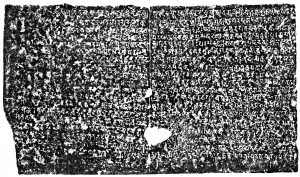
Deo-Baranark Inscription of Jivitagupta II
There was a king, Âdityasêna, of renowned prowess, equal in glory to the gods; the ruler of the (whole) earth up to the shores of the oceans; the performer of the aśvamêdha and other great sacrifices. On the full-moon day of (the month) Mâgha, coupled with the sign of (the lunar asterism) Viśakhâ, in the Kṛita age, ―having arrived from the Chôla city,―having sacrificed with three aśvamêdha sacrifices, (and) having given away his own weight a thousand times over, together with a crore of horses,―he, with (his) consort, the glorious Kôshadêvi, caused to be made the whole of this famous work (kîrtti), with three myriads of large jewels (and) three lakhs of gold (coins of the kind called)ṭankakas. Having consecrated (it) according to due rite (though the ceremonies performed) by Brâhmaṇs, just as if he, the king, himself (was laying out) the path of the Vêdas, he made an establishment of (the god) Nṛihari, who is the cause of the prosperity of the three worlds. A boar (i.e., the god Vishṇu in that form), the giver of enjoyment and final emancipation, has been set up by Balabhadra, in order that (his) parents may attain heaven, (and) for the happiness of the (whole) world. Thus runs the chapter on the Mandâragiri.